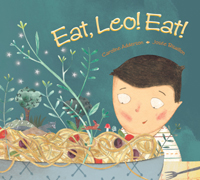| ________________
CM . . .
. Volume XXI Number 41. . . .June 26, 2015

 |
Eat, Leo! Eat!
Caroline Adderson. Illustrated by Josée Bisaillon.
Toronto, ON: Kids Can Press, 2015.
32 pp., hardcover, $18.95.
ISBN 978-1-77138-013-3.
Kindergarten-grade 2 / Ages 5-7.
Review by Meredith Cleversey.
**** /4
|
| |
|

excerpt:
“Leo,” Nonna says as the family sits down. “What’s the matter?”
“I’m not hungry.”
“Not hungry for stelline? Not hungry for little stars? Hmm.”
Nonna ladles out the zuppa. Mamma passes around the bowls.
“Leo, do you know why the pasta in this zuppa is called stelline? There’s a story,” Nonna says.
“A story?” Leo asks.
Every Sunday, Leo and his family gather at Nonna’s house for lunch. Leo would rather play than join the others at the table, but when Nonna starts telling him stories about the pastas she serves, Leo becomes much more interested in eating.
Eat, Leo! Eat!, written by Caroline Adderson and illustrated by Josée Bisaillon, is an engaging tale about family traditions and the power of storytelling. Leo has no interest in eating Sunday lunch with his family, but when his Nonna begins telling him a story about the food being served, he’s enticed enough to join the table. When the next Sunday rolls around, Nonna tells more of the story, and soon Leo comes to expect a new installment of the tale each week. As Nonna’s story continues, Leo becomes more excited, and before long, everyone in the family is eating and listening together.
The story-within-a-story in Eat, Leo! Eat! is as interesting as Leo’s own tale. To make Leo excited about eating, Nonna tells him an origin story about the pasta she serves for lunch. Each week, the story gets a little longer as the boy in the tale travels to his own Nonna’s house, using stars (stelline) to guide him, paving stones (chiancaredde) to walk on, and encountering various other aids and obstacles resembling different types of pasta. The Italian names of the pasta are used throughout Eat, Leo! Eat!, giving readers an introduction to the culture from which these foods come. A list of additional pasta types is also included at the back of the book, highlighting pastas not seen in the story, such as twins (gemelli) and little hats (cappelletti).
Josée Bisaillon’s collage-style illustrations in Eat, Leo! Eat! are comprised of playful drawings and paper patterns. The scenes with Leo and his family are full of the comfortable, happy expressions of characters engaging in a cherished tradition of eating together, while the scenes of Nonna’s story often have a touch of whimsy, such as when the boy and his Nonna are surrounded by colourful butterflies fluttering across the page. This is a story all about sharing, and the full-page illustrations, with their multitude of layered patterns and colourful drawings, are perfect for exploring as a group.
Eat, Leo! Eat! showcases the ways storytelling can help us connect to the world around us, and bring us closer together as well. A lovely tale for families and friends to share.
Highly Recommended.
Meredith Cleversey is a librarian in Cambridge, ON. She loves to read, write, and live in a world of pure imagination.

To comment
on this title or this review, send mail to cm@umanitoba.ca.
Copyright © the Manitoba Library Association. Reproduction for personal
use is permitted only if this copyright notice is maintained. Any
other reproduction is prohibited without permission.
Next Review | Table of Contents For This Issue - June 26, 2015
CM Home | Back Issues
| Search
| CM Archive
| Profiles Archive
|
